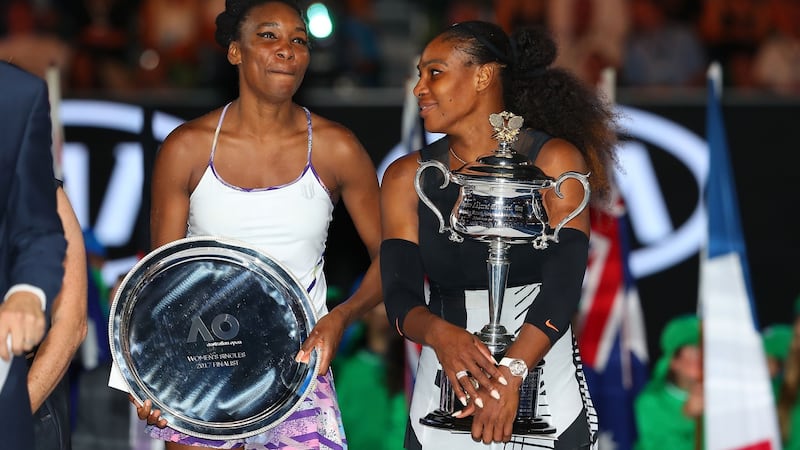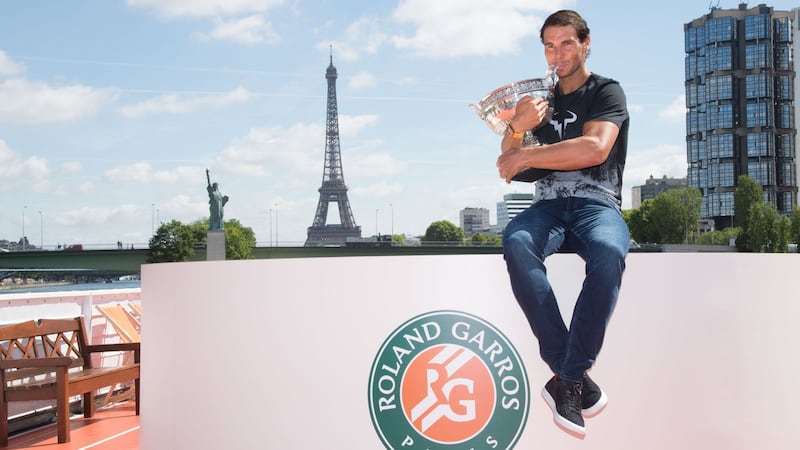If the year was distilled down into a couple of tennis-shaping events it was Serena Williams having a baby and defying time and Roger Federer undergoing a renaissance and, well, defying time.
Both players are 36-years-old and with each win seemed to enter a new history-making epoch.
Federer against time, why not? He has beaten everything else. Serena, like the Swiss, successfully battled against the younger women at the Australian Open and then vanished in April to have her first child.


That to the professional tennis population was an invitation to come and feed in the Grand Slam trough without the alpha female available to play.
Jelena Ostapenko at the French, Garbine Murguruza at Wimbledon and Sloan Stephens at the US Open gobbled up the other titles. Without Williams it was a feeding frenzy but in Stephens winning in New York it was another player on the road back making good. Because of a foot injury the American had not been allowed to hit a ball or run until May.
Fededer (back) and Rafa Nadal (wrist) also began the year coming off physical challenges, while the rest of the season saw the main actors Novak Djokovic, Andy Murray, Stan Wawrinka and Milos Raonic among others struggle with their bodies again raising the issue of five set matches and the transformation of what was once a lawn pastime into a power sport.
It was a strange kind of emergence for Federer as doubt propelled him into the unknown at the beginning of the year. He had undergone surgery for the first time in his career in 2016, itself a major accomplishment and completed the lengthy rehab before the first Grand Slam.
But Fededer also went into Melbourne with a significant change to his mindset. Starting the year as a 35-year-old the Swiss had, for the first time, decided to miss out on Roland Garros in order to preserve himself physically.
Clay had never been Federer’s strongest surface but the survivor in him said that the most gruelling of the four Grand Slam events must go from his schedule.
It was to be the Australian Open in January that would, in hindsight, crown Federer’s year and although he also won Wimbledon to make it a two slam season (with Nadal claiming the others in Paris and New York) Melbourne stood out because it was there he beat the Spaniard for the first time in a Slam final since Wimbledon 2007.
It was a stunning final during which Federer was forced to come back in the fifth set. But it was the dimensions of the match that made it a game for the ages; five sets lasting three hours 38 minutes and Federer claiming his 18th Grand Slam title.
Federer had also decided to ‘play free,’ which meant play the ball, not the opponent. He was free in his head, free in his shots and he came back from 1-3 down in the fifth.
By the end of 2017 he had the most number of grand slams since 2009, most titles since 2007, and highest win percentage since 2006. Statistically, this season was his best in 10 years.
Williams was also setting trends even though hers was limited to just one Major event. Winning the Australian Open for an open era record seventh time – defeating her sister Venus in the final – was quite an achievement before going on to tend to the rest of her pregnancy and give birth to baby Alexis.
It was the then 35-year-old’s 23rd Grand Slam singles title, surpassing Steffi Graf’s open era record of 22 and setting her up in 2018 for a tilt at Australian Margaret Court’s record of 24 titles.
Australia was also the first time in the open era that two players aged 35 or older competed in the final of a Grand Slam tournament with the win ensuring Serena a return to the number one ranking.
Williams subsequently withdrew from the Indian Wells and Miami Opens, citing a knee injury and in April revealed that she was 20 weeks pregnant.
Nadal was ploughing his own successful furrow and while he won in France, ending a three year drought of Grand Slams, he lost in the round of 16 to Gilles Mueller at Wimbledon a few weeks later.
New York brought more success as he earned his third US Open title against first-time Grand Slam finalist Kevin Anderson. As the season closed Nadal, at the age of 31 became the oldest person to finish as year-end number one and the first player to hold, lose and regain the year-end number one on three occasions (no one has done it twice).
In Ireland no player made it into a Grand Slam singles main draw. James Magee played all four qualifying tournaments, getting to the final round in Australia but falling short, while Simon Carr continued to show potential, making it to the last 16 in the US Junior Open.















